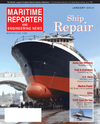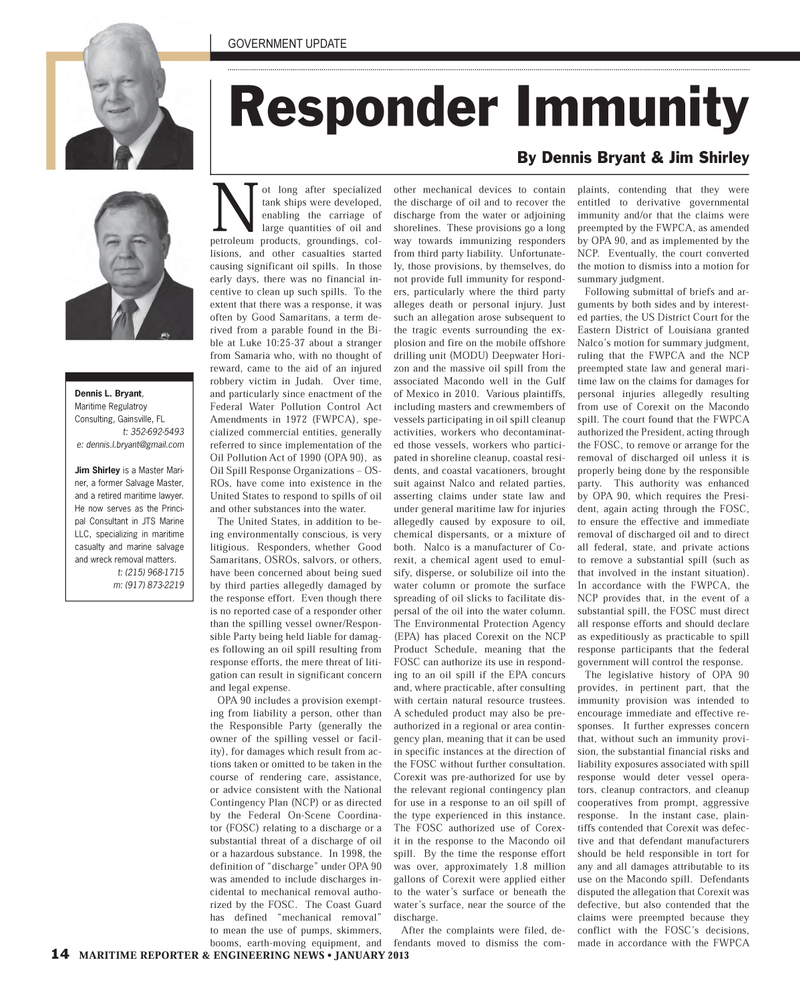
Page 14: of Maritime Reporter Magazine (January 2013)
Ship Repair & Conversion
Read this page in Pdf, Flash or Html5 edition of January 2013 Maritime Reporter Magazine
14 MARITIME REPORTER & ENGINEERING NEWS ? JANUARY 2013 GOVERNMENT UPDATE Responder ImmunityBy Dennis Bryant & Jim ShirleyDennis L. Bryant, Maritime Regulatroy Consulting, Gainsville, FLt: 352-692-5493e: [email protected] Shirley is a Master Mari-ner, a former Salvage Master, and a retired maritime lawyer. He now serves as the Princi-pal Consultant in JTS Marine LLC, specializing in maritime casualty and marine salvage and wreck removal matters. t: (215) 968-1715m: (917) 873-2219Not long after specialized tank ships were developed, enabling the carriage of large quantities of oil and petroleum products, groundings, col-lisions, and other casualties started causing significant oil spills. In those early days, there was no financial in-centive to clean up such spills. To the extent that there was a response, it was often by Good Samaritans, a term de-rived from a parable found in the Bi-ble at Luke 10:25-37 about a stranger from Samaria who, with no thought of reward, came to the aid of an injured robbery victim in Judah. Over time, and particularly since enactment of the Federal Water Pollution Control Act Amendments in 1972 (FWPCA), spe-cialized commercial entities, generally referred to since implementation of the Oil Pollution Act of 1990 (OPA 90), as Oil Spill Response Organizations ? OS- ROs, have come into existence in the United States to respond to spills of oil and other substances into the water. The United States, in addition to be-ing environmentally conscious, is very litigious. Responders, whether Good Samaritans, OSROs, salvors, or others, have been concerned about being sued by third parties allegedly damaged by the response effort. Even though there is no reported case of a responder other than the spilling vessel owner/Respon-sible Party being held liable for damag-es following an oil spill resulting from response efforts, the mere threat of liti- gation can result in significant concern and legal expense. OPA 90 includes a provision exempt- ing from liability a person, other than the Responsible Party (generally the owner of the spilling vessel or facil-ity), for damages which result from ac-tions taken or omitted to be taken in the course of rendering care, assistance, or advice consistent with the National Contingency Plan (NCP) or as directed by the Federal On-Scene Coordina-tor (FOSC) relating to a discharge or a substantial threat of a discharge of oil or a hazardous substance. In 1998, the definition of ?discharge? under OPA 90 was amended to include discharges in- cidental to mechanical removal autho-rized by the FOSC. The Coast Guard has defined ?mechanical removal? to mean the use of pumps, skimmers, booms, earth-moving equipment, and other mechanical devices to contain the discharge of oil and to recover the discharge from the water or adjoining shorelines. These provisions go a long way towards immunizing responders from third party liability. Unfortunate- ly, those provisions, by themselves, do not provide full immunity for respond-ers, particularly where the third party alleges death or personal injury. Just such an allegation arose subsequent to the tragic events surrounding the ex-plosion and fire on the mobile offshore drilling unit (MODU) Deepwater Hori-zon and the massive oil spill from the associated Macondo well in the Gulf of Mexico in 2010. Various plaintiffs, including masters and crewmembers of vessels participating in oil spill cleanup activities, workers who decontaminat-ed those vessels, workers who partici-pated in shoreline cleanup, coastal resi-dents, and coastal vacationers, brought suit against Nalco and related parties, asserting claims under state law and under general maritime law for injuries allegedly caused by exposure to oil, chemical dispersants, or a mixture of both. Nalco is a manufacturer of Co-rexit, a chemical agent used to emul-sify, disperse, or solubilize oil into the water column or promote the surface spreading of oil slicks to facilitate dis-persal of the oil into the water column. The Environmental Protection Agency (EPA) has placed Corexit on the NCP Product Schedule, meaning that the FOSC can authorize its use in respond-ing to an oil spill if the EPA concurs and, where practicable, after consulting with certain natural resource trustees. A scheduled product may also be pre- authorized in a regional or area contin-gency plan, meaning that it can be used in specific instances at the direction of the FOSC without further consultation. Corexit was pre-authorized for use by the relevant regional contingency plan for use in a response to an oil spill of the type experienced in this instance. The FOSC authorized use of Corex-it in the response to the Macondo oil spill. By the time the response effort was over, approximately 1.8 million gallons of Corexit were applied either to the water?s surface or beneath the water?s surface, near the source of the discharge. After the complaints were filed, de-fendants moved to dismiss the com-plaints, contending that they were entitled to derivative governmental immunity and/or that the claims were preempted by the FWPCA, as amended by OPA 90, and as implemented by the NCP. Eventually, the court converted the motion to dismiss into a motion for summary judgment. Following submittal of briefs and ar- guments by both sides and by interest-ed parties, the US District Court for the Eastern District of Louisiana granted Nalco?s motion for summary judgment, ruling that the FWPCA and the NCP preempted state law and general mari-time law on the claims for damages for personal injuries allegedly resulting from use of Corexit on the Macondo spill. The court found that the FWPCA authorized the President, acting through the FOSC, to remove or arrange for the removal of discharged oil unless it is properly being done by the responsible party. This authority was enhanced by OPA 90, which requires the Presi- dent, again acting through the FOSC, to ensure the effective and immediate removal of discharged oil and to direct all federal, state, and private actions to remove a substantial spill (such as that involved in the instant situation). In accordance with the FWPCA, the NCP provides that, in the event of a substantial spill, the FOSC must direct all response efforts and should declare as expeditiously as practicable to spill response participants that the federal government will control the response. The legislative history of OPA 90 provides, in pertinent part, that the immunity provision was intended to encourage immediate and effective re- sponses. It further expresses concern that, without such an immunity provi-sion, the substantial financial risks and liability exposures associated with spill response would deter vessel opera-tors, cleanup contractors, and cleanup cooperatives from prompt, aggressive response. In the instant case, plain-tiffs contended that Corexit was defec- tive and that defendant manufacturers should be held responsible in tort for any and all damages attributable to its use on the Macondo spill. Defendants disputed the allegation that Corexit was defective, but also contended that the claims were preempted because they conflict with the FOSC?s decisions, made in accordance with the FWPCA MR #1 (10-17).indd 14MR #1 (10-17).indd 141/2/2013 10:14:51 AM1/2/2013 10:14:51 AM

 13
13

 15
15
